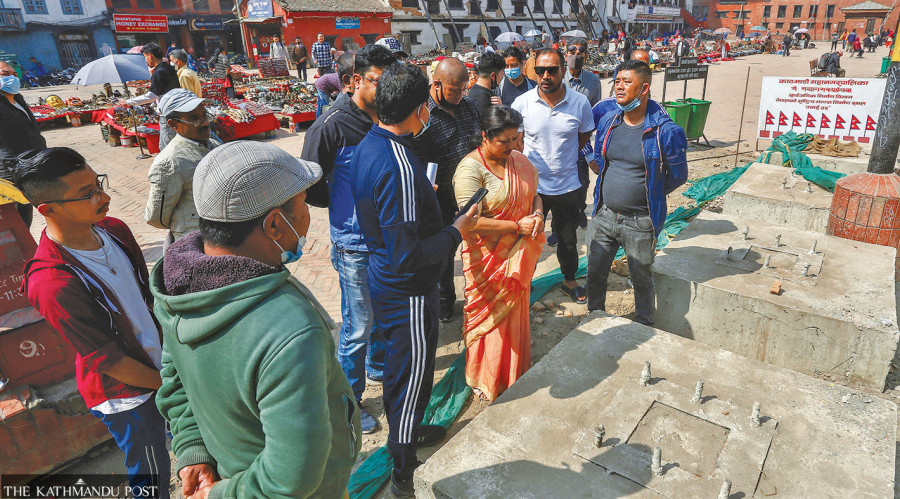Valley
City draws flak for erecting plinths at Basantapur
Heritage activists on Tuesday evening cut off flag poles. Kathmandu deputy mayor blames mayor for construction without consultation.
Anup Ojha
The Kathmandu Metropolitan City, yet again, has invited controversy by erecting concrete structures at the Kathmandu Durbar Square, which is a UNESCO World Heritage Site.
Earlier in 2017, the City had drawn strong criticism from heritage activists and civil society members for using concrete while restoring the historical Rani Pokhari pond, and last year it faced similar rebuke for using concrete to line the bed of the Kamal Pokhari pond. After criticisms the City had backtracked from its plan on both the occasions.
But on Saturday night, the City hastily erected eight concrete plinths, each around two feet tall, on the edge of the Dabali [raised platform] on the southern side of the Nautale Durbar to install 35 feet tall posts to fly Nepali national flags.
“The city constructed the concrete structures overnight to avoid protest from locals and heritage activists,” said Ganapati Lal Shrestha, a local resident of Basantapur area and activist.
“We have a huge respect for the national flag and there are already places to fly them, like at the entrance to the Durbar Square. So why is this mayor, Bidya Sundar Shakya, so keen to defile the UNESCO Heritage Site by erecting concrete plinths?” questioned Shrestha.
On Tuesday afternoon, after widespread criticism from locals, heritage activists and the media, the Deputy Mayor of Kathmandu Metropolitan City Hari Prabha Khadgi, who is also the chief of the inspection committee of the City, visited Basantapur and ordered immediate halt to the ongoing construction. She announced that the concrete plinths will be removed.
On Tuesday evening locals and activists cut off the flag posts. They said they would also dismantle the concrete plinths.
“Basantapur area is a historically important area. But Mayor Shakya gave permission to construct such structures without consulting the municipal office bearers,” said Khadgi.
An official at the City requesting anonymity said the City is also planning to erect similar concrete flag posts at three other UNESCO World Heritage sites in the Valley: Swayambhu, Pashupati and Bauddha. It also plans to construct similar flag posts at Rani Pokhari.
“It is unfortunate that the City has not learned from the mistakes it made at Rani Pokhari and Kamal Pokhari,” said Shrestha, the heritage activist. He said activists like him will blunt any attempts by the City to ‘defile’ historical sites in the Valley.
On Monday, the Department of Archeology had written to the District Administration Office, Kathmandu, the Kathmandu Metropolitan City office and other stakeholders to remove the concrete plinths from Basantapur.
“Earlier also the department had written to the City but the latter didn't stop the construction work. But it halted the work only after protests by locals and activists,” said Damodar Gautam, director general at the Department of Archeology, who also visited the Durbar Square on Tuesday.
Modern constructions are prohibited at Kathmandu Durbar Square. Also the Ancient Monument Preservation Act 2013 (1956) states that structures over a hundred years old must be preserved in their original form, and constructing any new infrastructure is restricted in the area.
“The city must abide by the law, and we request the City to be sensitive towards such historical sites and monuments,” added Gautam.
Meanwhile, Sandeep Khanal, executive director at the Hanumandhoka Palace Management and Conservation Office, said his office was aware of the new construction work by the City, but could not do anything to stop it.
“Because the Kathmandu Metropolitan City itself is an autonomous body, and it never listens to us,” said Khanal.
Khanal said his office had requested the City not to erect the concrete plinths. “But they did not heed,” averred Khanal while thanking the activism by the locals.
In 2017, a team of experts from UNESCO held a meeting in Krakow of Poland to decide whether Kathmandu Valley, devastated by the massive earthquake in 2015, should be placed on the UNESCO list of World Heritage in danger.
“The City’s act had really worried us, but thanks to the activists who have stopped the construction,” said Devendra Bhattarai, an officer at the Department of Archaeology.




 19.12°C Kathmandu
19.12°C Kathmandu.jpg)











